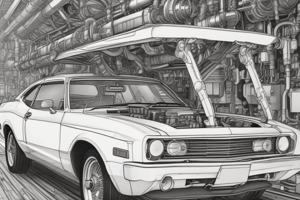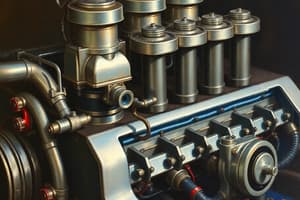Podcast
Questions and Answers
What is the primary function of cowl flaps in an aircraft's cooling system?
What is the primary function of cowl flaps in an aircraft's cooling system?
- To control the cooling of the engine. (correct)
- To improve aerodynamic performance.
- To reduce fuel consumption.
- To increase engine power.
What happens when cowl flaps are opened wide during ground operations?
What happens when cowl flaps are opened wide during ground operations?
- It maintains the engine at the red-line temperature.
- It greatly increases drag without concern for cooling. (correct)
- It reduces engine pressure significantly.
- It prevents the use of augmentors.
In an aircraft equipped with cowl flaps, what gauge must be installed?
In an aircraft equipped with cowl flaps, what gauge must be installed?
- Engine oil pressure gauge.
- Cylinder head temperature gauge. (correct)
- Fuel level gauge.
- Altitude gauge.
Which type of thermocouple is used to connect to the cylinder when installing a temperature gauge?
Which type of thermocouple is used to connect to the cylinder when installing a temperature gauge?
How do augmentors contribute to cooling in aircraft?
How do augmentors contribute to cooling in aircraft?
What is the disadvantage of opening cowl flaps for increased cooling during flight?
What is the disadvantage of opening cowl flaps for increased cooling during flight?
Which system is not typically involved in the cooling alterations referenced in FAR 43 - Appendix A?
Which system is not typically involved in the cooling alterations referenced in FAR 43 - Appendix A?
What is the role of baffles in the cooling system of an aircraft?
What is the role of baffles in the cooling system of an aircraft?
What is one of the principal reasons for managing excessive heat in an internal combustion engine?
What is one of the principal reasons for managing excessive heat in an internal combustion engine?
What percentage of heat released by aircraft fuel is converted into useful power?
What percentage of heat released by aircraft fuel is converted into useful power?
How does circulating oil assist in the cooling process of an aircraft engine?
How does circulating oil assist in the cooling process of an aircraft engine?
Why are cooling fins used on the engine's cylinders?
Why are cooling fins used on the engine's cylinders?
What role do cowling and baffles play in an engine's cooling system?
What role do cowling and baffles play in an engine's cooling system?
What may happen if too much cooling fin area gets broken off from the cylinder?
What may happen if too much cooling fin area gets broken off from the cylinder?
What is the purpose of blast tubes in baffles?
What is the purpose of blast tubes in baffles?
How do inter-cylinder and cylinder head baffles affect cooling air flow?
How do inter-cylinder and cylinder head baffles affect cooling air flow?
Study Notes
Reciprocating Engine Cooling Systems
- Excessive engine heat leads to premature combustion, detonation, and damage.
- Approximately 75% of heat generated by aircraft fuel is not converted into useful power and must be dissipated.
- Half the engine heat exits through exhaust, the other half is absorbed by the engine.
- Engine oil absorbs some heat and transfers it to the airstream via an oil cooler.
- The engine cooling system manages the remaining engine heat.
Cylinder Cooling
- Cylinders are typically large and require surface area enhancement (cooling fins) for efficient heat dissipation.
- Damage to cooling fins reduces cooling efficiency and creates hotspots.
- Cowling and baffles direct airflow over cooling fins, preventing stagnant air pockets.
- Blast tubes within baffles can direct cooling air to engine accessories.
- Inter-cylinder and cylinder head baffles force cooling air close to engine parts.
- Air baffles increase air's contact time with the cylinder by preventing rapid airflow.
- Although baffles slightly impede cooling airflow, they significantly decrease the overall air volume needed.
Cooling Control
- Cowl flaps, controlled manually, electrically, or hydraulically, regulate cooling airflow.
- Open cowl flaps increase cooling but also increase drag, reducing streamlining.
- Cowl flaps should be fully open during ground operations for maximum cooling.
- Aircraft with cowl flaps require cylinder head temperature gauges: A thermocouple (bayonet or gasket type) monitors cylinder temperature and sends the data to an indicator.
- Augmentors can increase cooling airflow by using exhaust gas velocity.
- Pressure-cooled systems use the exhaust gases to pump air: Intake through nose cowling and exhaust ejectors create this airflow. They obviate the need for cowl flaps.
Regulations
- Changes to engine cooling systems are considered major alterations under FAR 43 Appendix A.
Studying That Suits You
Use AI to generate personalized quizzes and flashcards to suit your learning preferences.
Related Documents
Description
Explore the intricacies of cooling systems in reciprocating engines. Understand how excess heat affects engine performance and the roles of various components like oil coolers and cooling fins. This quiz covers essential concepts for maintaining optimal engine temperatures and preventing damage.





